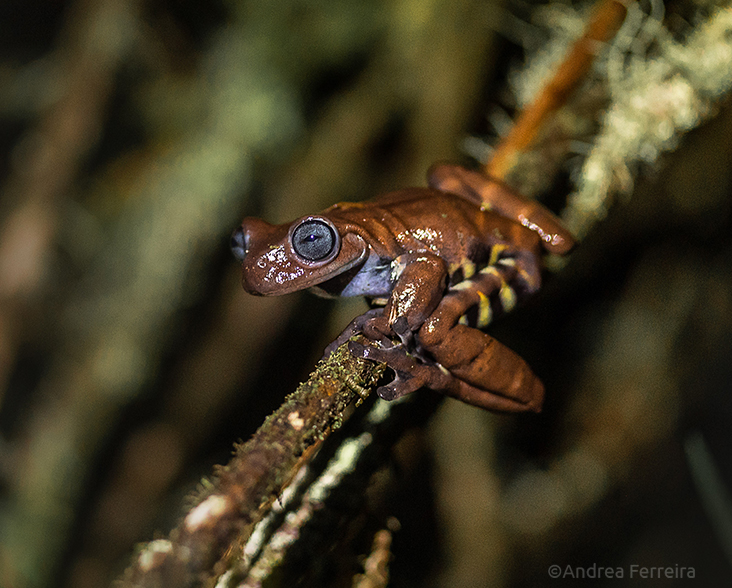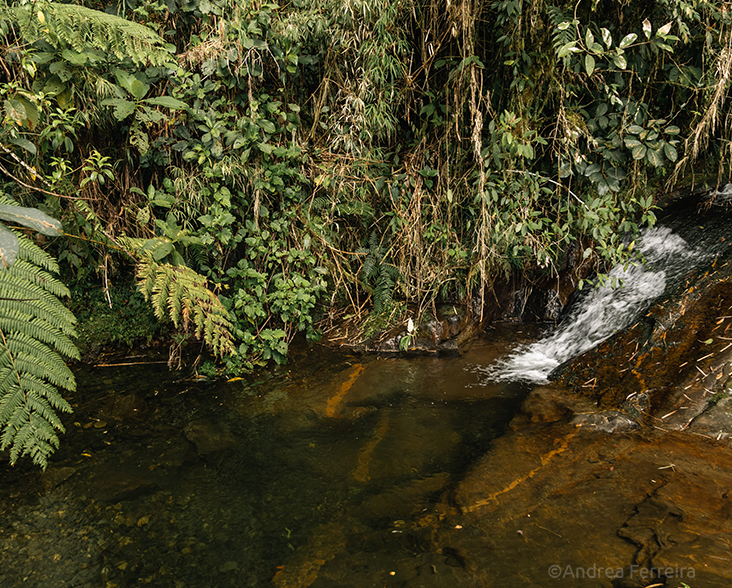Antioquia Chocolate Frog
Species Data
Class: Amphibia
Order: Anura
Family: Hylidae
Scientific Name: Hyloscirtus antioquia
IUCN Red List status: Vulnerable
Description
Discovered in 2010, the Antioquia Chocolate Frog was described as a new species of tree frog in 2013. The dorsum is a dull reddish-brown with or without a scattered rough reticular pattern of orange markings, and the black or grey flanks have yellow markings with blue or pale-grey outlines. The ventral surfaces are grey, the gular region is brown, and the snout rounded. The thighs are yellow with black stripes, and the hands, feet and webbing are grey with black bars, with dark-brown epidermal projections on the nuptial pads. The grey iris has burgundy reticulations. Adult males are 55.7 mm from snout to vent, and females are slightly larger at 61 mm, with slimer forearms and lacking nuptial pads.
The tadpoles are olive-brown with a golden mid-dorsal stripe along the tail and a tan-brown stripe on either side. The body shape is ovoid or depressed with a rounded snout, and the muscular tail is long, approximately 69% of the total length, with low fins.
Behaviour
This species is found in streamside vegetation, typically small trees and Chusquea bamboo, less than 3 m above ground, and in bromeliads and Espeletia subshrubs some distance from water.
Males call from dusk to early morning when activity decreases. The low-pitched pulsing notes are similar to the stridulation produced by crickets and sometimes difficult to hear above the sound of the water.
Tadpoles develop in streams, but nothing is known about amplexus or egg clutches.
When handled, adults change from reddish-brown to grey, and often release a bitter white secretion and a strong smell.


Habitat
The Antioquia Chocolate Frog is endemic to the Central Cordillera of the Colombian Andes, where it inhabits streams and puddles formed by flowing water in the cloud forests of high mountains and subpáramo between 2500–3200 m above sea level.
Threats and Conservation
The Antioquia Chocolate Frog is not an abundant species, known from just eight locations. Although considered stable, the population is severely fragmented, with no exchange of individuals between the isolated streams in which this species lives. Threats include habitat loss and degradation due to urban expansion, introduced species such as Rainbow Trout, and chytridiomycosis—an infectious and deadly pathogen caused by the waterborne fungus Batrachochytrium dendrobatidis (Bd) that affects the respiratory and nervous system of amphibians.
This species occurs in several protected areas including the Guanacas Reserve created in 1990 by WLT partner Fundación Guanacas Bosques de Niebla, that protects 520 ha (1,285 acres) of cloud forest, montane streams, and naturally regenerating pasture in the Andes of north-western Columbia. Therefore, the Antioquia Chocolate Frog is listed as Vulnerable on the IUCN Red List.
WLT is supporting a project by partner Fundación Guanacas Bosques de Niebla to expand the Guanacas Reserve and safeguard the montane streams vital to the long-term survival of the Antioquia Chocolate Frog.
